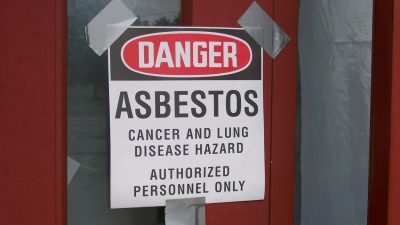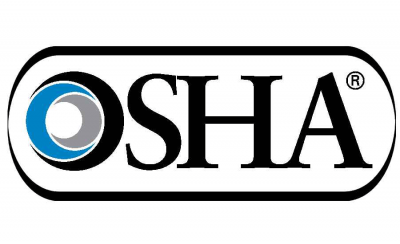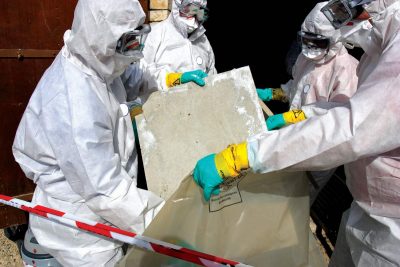AFSCME has played a major role in shaping federal asbestos laws to protect maintenance, custodial, and other building service workers and occupants. These laws give workers the right to know if the buildings they work in contain asbestos-containing materials (ACM) and require strict work practices to prevent exposure.
The Occupational Safety and Health Administration (OSHA) has two asbestos standards:
General Industry Standard (29 CFR 1910.1001) covers routine housekeeping activities in buildings and automotive brake and clutch repair.
Construction Standard (29 CFR 1926.1101) applies to demolition and renovation operations and other activities where asbestos is removed or encapsulated. It also covers building maintenance and repair activities and emergency cleanup of asbestos spills.
These standards cover private-sector workers and state and local government workers in the 23 states with federally approved state OSHA laws. A few other states have OSHA programs for public employees that are not federally approved which also adopts and enforces OSHA standards.
The United States Environmental Protection Agency (EPA) Asbestos Worker Protection Rule (40 CFR Part 763 Subpart G) extends the OSHA asbestos protections to state and local government workers not covered by OSHA laws. The law became effective on December 15, 2000.
What “right to know” do workers have about asbestos hazards?
Federal laws give workers the right to know about possible asbestos hazards in their workplaces. Except for primary and secondary schools, there is no requirement to inspect buildings for asbestos. However, the following materials are “presumed asbestos-containing material” (PACM) and must be handled accordingly if they were installed in buildings built before 1980.
- Pipe and boiler coverings (thermal system insulation or TSI),
- Sprayed or troweled on surfacing material such as fireproofing,
- Asphalt or vinyl flooring, and any other materials that an employer or building owner knows or should know contains asbestos.
- These materials must be treated as ACM unless they are tested (bulk sampling) and are found not to contain asbestos.
There are other ways that employers must inform workers and occupants about asbestos:
Signs posted at the entrance of rooms or areas with ACM and where asbestos work is being performed.
Labels attached to ACM products, containers of asbestos, including waste containers.
Training for custodial and maintenance workers on health hazards, locations of asbestos, signs of damage to ACM and PACM, and what to do if asbestos fibers are released. Construction and maintenance workers who disturb asbestos must receive additional training on proper work practices, respirators, protective clothing, and other topics.
Notification of asbestos work to those who work in or near an area where asbestos will be disturbed and the methods to contain asbestos fibers before the job begins.
How much asbestos can workers be exposed to legally?
OSHA permissible exposure limits (PEL) are the maximum levels that workers may be exposed to for particular substances. These are the limits that OSHA compliance officials can enforce. The PEL for asbestos is one-tenth of an asbestos fiber per cubic centimeter of air, or0.1f/cc averaged over an eight-hour shift. In addition, no employee may be exposed above the excursion limit, which is an airborne concentration of asbestos over one fiber per cubic centimeter of air (1f/cc) averaged over a 30 minute period.
Warning: Legal does not mean safe.
There is no level of exposure that is known to be safe!
What must employers do to protect workers?
The OSHA Construction Standard covers activities such as demolition, removal, repair, or encapsulation of ACM. It also covers building maintenance and custodial tasks. The Construction Standard divides asbestos work into four types, each with its own set of requirements:
- Class I asbestos work means activities in which thermal system insulation (pipe and boiler covering) or surfacing material such as sprayed-on fireproofing is removed.
- Class II asbestos work means the removal of asbestos-containing wallboard, floor tile and sheeting, roofing and siding shingles, and construction mastics.
- Class III asbestos work means repair and maintenance jobs where ACM (including thermal system insulation or surfacing materials) is likely to be disturbed.
- Class IV asbestos work means maintenance and custodial activities during which employees contact ACM or PACM and clean up waste containing ACM and PACM.
Measuring Worker Exposure
In general, employers must determine how much asbestos workers might be exposed to before the work begins (initial exposure assessment) unless they have reliable information that workers will not be exposed above the PEL. For Class I and II work, the employer must conduct daily monitoring (periodic monitoring) of each employee who works within the regulated area, unless a negative exposure assessment has been made. For Class III or IV work, the employer must monitor all work where exposures are expected to exceed the PEL unless workers are wearing supplied-air respirators operated in the positive-pressure mode.
The employer must also perform clearance sampling after Class I jobs to make sure that the area is safe to reenter. Before the plastic sheeting around an asbestos job is taken down, air measurements must be taken after stirring up the air with a leaf blower.
Required Work Practices
All Class I, II, and III asbestos work must be conducted within regulated areas. These are marked areas that only trained and authorized personnel wearing respirators and other protective equipment may enter. Other work, such as an emergency cleanup, must also be conducted in a regulated area when airborne asbestos levels are over or are likely to exceed the PEL.
Engineering controls: employers must use ventilation and other methods to keep asbestos fibers from getting airborne. Power tools such as drills, saws, abrasive wheels must be equipped with ventilation systems in order to capture the fibers. Whenever possible, wet methods must be used to keep asbestos moist to keep fibers from getting into the air.
Housekeeping and floor care: Employers must provide workers with a vacuum cleaner that is equipped with high-efficiency particulate air (HEPA) filters, or use wet methods such as mopping. Stripping floor finish must be done by wet methods or using low abrasion pads at lower than 300 rpm.
Brake and clutch repair: In addition to housekeeping, the OSHA General Industry Standard covers vehicle maintenance. Employers must provide equipment to enclose the brake or clutch and catch fibers during repairs (negative pressure enclosure/HEPA vacuum system). Employers may also use low pressure/wet cleaning method or other methods if exposures can be kept below the PEL.



